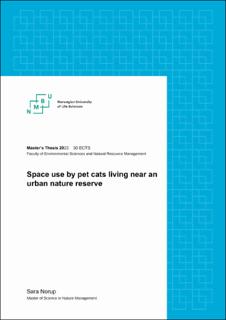| dc.description.abstract | Domestic cats (Felis catus) with outdoor access pose a significant threat to local wildlife worldwide, and a thorough understanding of their space use is needed to mitigate their ecological impact. Although knowledge about the spatial behavior of individual domestic cats is growing, we still know little about their habitat selection among the non-built-up areas in an urban environment.
Using a citizen science approach, we GPS-tagged and tracked the movement of 57 domestic cats with outdoor access living in an urban area surrounding Østensjøvannet nature reserve, a protected wetland area (0.53 km2) in southeastern Norway. The nature reserve consists of a lake (Østensjøvannet) surrounded by wetlands and other vegetation. The objective of this reserve is to preserve the important wetland areas with vegetation, birdlife and other wildlife from the increasing development pressure. The outdoor movement of the GPS-tagged cats was tracked for about 4 weeks during spring 2022. The resulting position data were analyzed using resource selection functions to investigate habitat selection outside of built-up areas by cats. In addition, I identify the proportion of the population actively using the nature reserve within the urban study area, as well as the duration and timing of their activity within the reserve.
My results reveal substantial variation in the selection of habitat in non-built-up areas. One or more cats significantly selected forest, open firm ground, bog and agricultural land. Only nine (15.9%) cats had registered positions within the reserve, and among them, only five cats had parts of their 95% BBMM home range within the reserve. The best predictor of reserve use by cats was the distance between a cat's home and the boundary of the reserve.
Results presented here suggest that establishing a buffer zone will be an effective measure to safeguard wildlife within protected areas. However, a buffer is not always applicable, and thus I suggest that each cat owner evaluates their own cats’ roaming behavior and take preventative actions, such as neutering, limiting outdoor time or access. Further, more studies are needed to investigate space use with the aim of identifying effective management strategies to lower the encounter rates between
domestic cats and wildlife. | |
